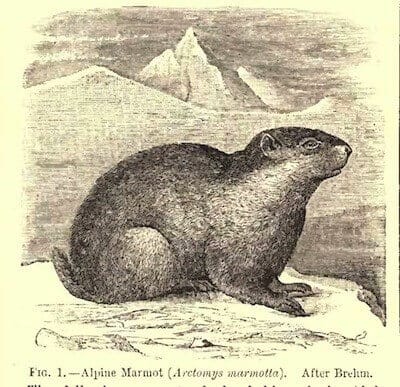Alpine marmots (Marmota marmota) live in extended family groups of up to 20 individuals. The groups consist of a dominant territorial pair and a number of subordinate individuals, typically descendants of the dominant pair. Over a 14-year period, Klaus Hackländer of the Institute of Wildlife Biology and Game Management, University of Natural Resources and Life Sciences, Vienna and Walter Arnold of the Research Institute of Wildlife Ecology (FIWI), University of Veterinary Medicine, Vienna investigated the lifetime reproductive success (typically measured by the number of offspring) of female Alpine marmots in a free-living population in Berchtesgaden National Park. Their results indicate a positive effect of male-bias in a litter on the development of a more aggressive female phenotype. This is important, as only the dominant female in a group gets to reproduce and the chance of a female’s becoming dominant is greater the more aggressive she is.
To determine females´ position in the uterus, Hackländer and Arnold used a non-invasive mark — recapture technique: they captured, marked, released and recaptured an average of 141 marmots per year and collected data on group composition, female reproductive output and relatedness among group members. By determining the sex ratio (the proportion of males in a litter) for each sample group, the scientists were able to calculate the likelihood that female group members were located next to a male in the uterus, as in male-biased litters there is a greater chance that a female developed next to one or two males. The scientists had expected to find an increase in aggression in such females but were surprised to discover that reproductive success is not negatively affected by prenatal masculinization.
Previous studies on other species have shown an influence of position in the uterus on subsequent development. In house mice (Mus musculus), for example, being located between two males appears to make females more aggressive but less reproductively successful. However, it was unknown so far whether this is of any importance in free-living wild animals. Moreover, the results on Alpine marmots seem to show the opposite effect: the greater the male-bias in a litter, the better the chance for females to become dominant and hence reproductively successful. An exposure to higher testosterone levels during foetal development thus seems to give female marmots an edge over other females in a population. As Arnold says, “Male marmots only mate with the dominant female in a group and clearly do not mind that she is a bit ‘butch’ — which she has to be to reach that position in the first place.”
The article “Litter sex ratio affects lifetime reproductive success of free-living female Alpine marmots Marmota marmota” by Klaus Hackländer and Walter Arnold is published in the journal Mammal Review (DOI: 10.1111/j.1365-2907.2011.00199.x).
Scientific contact:
Prof Walter Arnold, E [email protected] T 43-1-4890915-100
Released by:
Klaus Wassermann, E [email protected], T 43-1-25077-1153


